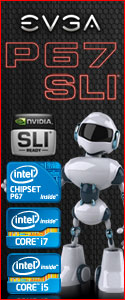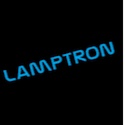The Kingston HyperX Genesis kit came packaged in a plastic clam shell, clear on one side and black on the other. On both sides of the container you will find tape with “Factory Sealed” printed on it. As long as the seal is not broken; this tape confirms the product inside is new and unused. We always like to see packaging that gives the end user that warm fuzzy feeling of getting what they paid for; and this packaging accomplishes that quite nicely. There is a large sticker applied to the package with the model number, bar code, and HyperX branding.
 |
 |
Removing the clear plastic cover reveals the four memory modules held securely in a black tray. Also, resting in the tray is a warranty and installation pamphlet.
 |
 |
The heat spreaders are decked out with a blue color and some very attractive “HyperX Genesis” embossing. Near the bottom left of the modules is a red and black emblem. It took a closer look to determine exactly what this emblem was. As it turns out, it’s a facial image of an ancient, Egyptian character – the logo for the Genesis product line. Each of the four modules have a sticker attached displaying the model number, voltage requirements, and serial numbers.
 |
 |
 |
 |
Moving along to the features and specifications of the HyperX Genisis KHX1866C9D3K4/16GX kit, we find the memory has three XMP timing parameters programmed and ready to use. Here are the values applied to those three XMP profiles:
• JEDEC: DDR3-1333 CL9-9-9 @1.5V
• XMP Profile #1: D3-1866 CL9-11-9 @1.65V
• XMP Profile #2: D3-1600 CL9-9-9 @1.65V
You may have noticed by looking at the above, the required voltage for running this memory at its advertised 1866Mhz speed is 1.65v. While the Intel specifications for SB-E processors (Quad Channel X79 Platform) say that memory voltage of 1.5v is preferred; many users out there are using 1.65v without issues. The SB-E platform is said to be robust enough to handle the 1.65v long term. There must be a certain amount of validity to this; as many memory manufactures are now offering quad channel kits at 1.65v.
Features
• JEDEC standard 1.5V (1.425V ~ 1.575V) Power Supply
• VDDQ = 1.5V (1.425V ~ 1.575V)
• 667MHz fCK for 1333Mb/sec/pin
• 8 independent internal bank
• Programmable CAS Latency: 9, 8, 7, 6
• Posted CAS
• Programmable Additive Latency: 0, CL – 2, or CL – 1 clock
• Programmable CAS Write Latency(CWL) = 7 (DDR3-1333)
• 8-bit pre-fetch
• Burst Length: 8 (Interleave without any limit, sequential with
starting address “000” only), 4 with tCCD = 4 which does not
allow seamless read or write [either on the fly using A12 or MRS]
• Bi-directional Differential Data Strobe
• Internal(self) calibration : Internal self calibration through ZQ
pin (RZQ : 240 ohm ± 1%)
• On Die Termination using ODT pin
• Average Refresh Period 7.8us at lower than TCASE 85°C,
3.9us at 85°C < TCASE < 95°C
• Asynchronous Reset
• PCB : Height 1.18” (30mm) w/ heat spreader,
double sided component
Specifications
| CL (IDD) | 9 Cycles |
| Row Cycle Time (tRCmin) | 49.5ns. (min) |
| Refresh to Active/Refresh Command Time (tRFCmin) |
160ns (min) |
| Row Active Time (tRASmin) | 36ns (min) |
| Power (Operating) | 1.410 W (Per Module) |
| UL Rating | 94 V -0 |
| Operating Temperature | 0°c to 85°c |
| Storage Temperature | -55°c to +100°c |
Additional Information as Provided by Kingston
Kingston’s KHX1866C9D3K4/16GX is a kit of four 512M x 64-bit (4GB) DDR3-1866 CL9 SDRAM (Synchronous DRAM) 2Rx8memory modules, based on sixteen 256M x 8-bit DDR3 FBGA components per module. Each module kit supports Intel® XMP (Extreme Memory Profiles). Total kit capacity is 16GB. Each module kit has been tested to run at DDR3-1866 at a low latency timing of 9-11-9 at 1.65V. The SPDs are programmed to JEDEC standard latency DDR3-1333 timing of 9-9-9 at 1.5V. Each 240-pin DIMM uses gold contact fingers.

 Posted in
Posted in 



